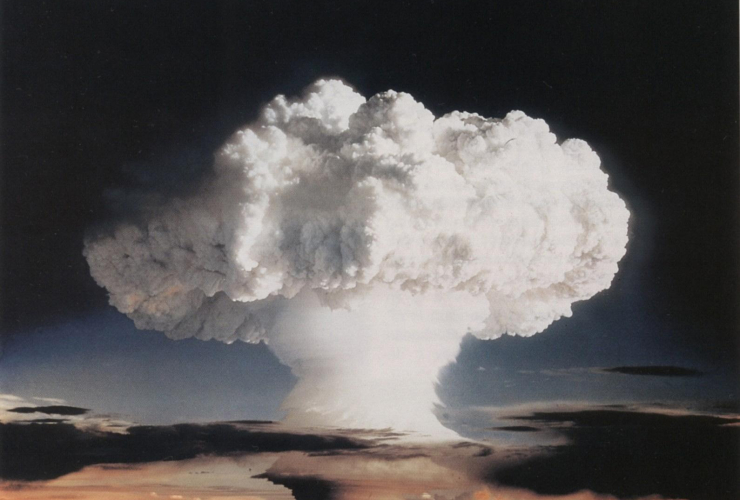This story was originally published by The Guardian and appears here as part of the Climate Desk collaboration.
The site to represent the start of the Anthropocene epoch on Earth has been selected by scientists. It will mark the end of 11,700 years of a stable global environment in which the whole of human civilization developed and the start of a new age, dominated by human activities.
The site is a sinkhole lake in Canada. It hosts annual sediments showing clear spikes due to the colossal impact of humanity on the planet from 1950 onwards, from plutonium from hydrogen bomb tests to the particles from fossil fuel burning that have showered the globe.
If the site is approved by the scientists who oversee the geological timescale, the official declaration of the Anthropocene as a new geological epoch will come in August 2024.
Experts said the decision has social and political importance, as well as great scientific value, as it would testify to the “scale and severity of the planetary transformation processes unleashed by industrialized humanity.”
The climate crisis is the most prominent impact of the Anthropocene, but huge losses of wildlife, the spread of invasive species and the widespread pollution of the planet with plastics and nitrates are also key features.
The Anthropocene Working Group was set up in 2009 and in 2016 concluded that the human-caused changes to Earth were so great that a new geological time unit was justified. The AWG then assessed in detail a dozen sites across the world as candidates for what geologists call a “golden spike” — the place where the abrupt and global changes marking the start of the new age are best recorded in geological strata.
Candidate sites included tropical corals in the U.S. and Australia, a mountainous peat bog in Poland, the Antarctic ice sheet and even the human debris accumulated under the city of Vienna. However, after several rounds of voting by the AWG, Crawford Lake, near Toronto, was selected.
“There is compelling evidence globally of a massive shift, a tipping point, in the Earth’s system,” said Prof. Francine McCarthy, a geologist at Brock University and an AWG member. “Crawford Lake is so special because it allows us to see at annual resolution the changes in Earth's history.”
The lake, formed in a limestone sinkhole, is 24 metres deep but only 2.4 hectares in area. That tall shape means the bottom waters and surface waters do not mix, which would confuse the record laid down in the sediments. “The bottom of the lake is completely isolated from the rest of the planet, except for what gently sinks to the bottom and accumulates in sediment,” McCarthy said.
The AWG has chosen the plutonium isotopes from H-bomb tests as the key marker for the Anthropocene, as they were spread globally from 1952 but declined rapidly after the Nuclear Test Ban Treaty in the mid-1960s, creating a spike in sediments.
“The presence of plutonium gives us a stark indicator of when humanity became such a dominant force that it could leave a unique global ‘fingerprint’ on our planet,” said Prof. Andrew Cundy, an environmental radiochemist at the University of Southampton and an AWG member.
There are other important markers in the lake sediments, including spherical carbon particles produced by the burning of fossil fuels in power plants and nitrates from the mass application of chemical fertilizers. “We have a dramatic increase in the concentration in our core at exactly the same depth that we see the rapid rise in plutonium,” said McCarthy.
The 1950s saw the start of the “great acceleration,” the unprecedented increase in industrial, transport and economic activity that occurred after the Second World War and continues today. “It is the great acceleration that we decided to use as a major tipping point in Earth's history. But it is the increase in plutonium 239 fallout specifically that we chose as the marker,” said McCarthy.
Prof. Jürgen Renn, director of the Max Planck Institute for the History of Science in Berlin said: “The Anthropocene concept has now received a firm anchoring in a very precise stratigraphic definition, [giving] a reference point for scientific discussions.
“It also creates a bridge between the natural sciences and the humanities, because it’s about the humans,” Renn said. “We are looking at something that is shaping our fate as humanity, so it’s very important to have a common reference point.”
Official ratification of the Crawford Lake site and the Anthropocene epoch requires passing three more votes of geological authorities, the subcommission on Quaternary Stratigraphy, the International Commission on Stratigraphy and finally the International Union of Geological Sciences.
The decision may be a difficult one for geologists, who are used to dealing with time periods spanning millions of years and using rocks with fossils as markers. The AWG will present a dossier of evidence hoping to convince the voting bodies that the Anthropocene does represent a planetary change that requires a new geological time period.
Dr. Alexander Farnsworth at the University of Bristol said plutonium is a radioactive element and decays over time, so it might not persist over geological timescales of millions. He also questioned whether an Anthropocene epoch is needed, saying: “We are but a ripple in the river of gene flow through time.”
Prof. Colin Waters, AWG chair from the University of Leicester, said: “The Anthropocene that starts in the 1950s represents a very rapid change that we have caused to the planet. There’s hope in that respect. The combined impacts of humanity can be changed rapidly for good and for bad. It’s not inevitable that we have to slide into continuing environmental poverty.”
The K-Pg boundary is defined
The K-Pg boundary is defined by a layer of iridium. Below, there are mostly dinosaurs. Above, there are mostly mammals.
The anthropocene is not an epoch, it’s a boundary. Defined by a layer of radioactivity and plastic. Below is the age of mammals; above will be what is left from the planet’s (human-caused) Sixth mass extinction event.
en.m.wikipedia.org/wiki/Cretaceous–Paleogene_boundary
Yes, an epoch is, or has been
Yes, an epoch is, or has been well beyond the scope/scale/observation of what the life forms on earth during the period, could track or consciously register. Evolution, that presumably mindless, unconscious force of nature has registered its changes in the earths strata but as we surmise, its record is incomplete and imperfect.
Within certain epochs there is evidence for relatively sudden, possibly violent events that can be linked to mass extinctions that seem to be the general guideline for the naming of epochs.
Within Earth's stratographic geological record there are also borders/boundaries that don't rise to the level of epoch making. The interesting thing about the putative Anthropocene is that humanity as it now exists , believes it can identify the Plutonium Boundary. and that with agreement, humanity, or its evolutionary successors may at some unimaginably distant future time be able to look back through the geological history and declare a new epoch, most likely using signifiers and communications modes (words and languages) we have not even contemplated.
We need to be awed and content to have witnessed and identified an event/boundary that represents a seminal change in the planet.






Comments